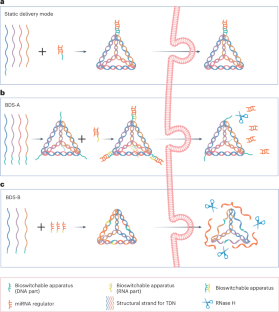基于四面体 DNA 纳米结构的微 RNA 治疗生物开关输送系统。
IF 13.1
1区 生物学
Q1 BIOCHEMICAL RESEARCH METHODS
引用次数: 0
摘要
由于微RNA(miRNA)几乎调控着人体内所有的生理病理活动,因此递送miRNA调节剂的miRNA疗法在核酸药物开发领域备受关注。使用四面体 DNA 纳米结构来递送 miRNA 调节剂很有前景,因为它们制作简单,能增强细胞进入能力,有效渗透组织,具有生物相容性和功能可编辑性。本方案是在我们之前使用四面体 DNA 纳米结构的方案基础上进行的扩展,旨在建立一种最新的生物开关递送系统(BDS),以实现可控的货物装载和释放。核糖核酸酶 H 敏感序列被设计成一种生物开关装置,用于定向释放 miRNA 调控因子。miRNA 调控因子的功能序列和退火过程中形成最小二级结构的趋势是货物设计的两个关键点。我们提供了两种 BDS 设计策略:BDS-A 包括一个完整的 DNA 四面体,RNA 货物悬挂在外面,具有成本低、简单、结构设计更直接等优点。在 BDS-B 设计中,RNA 调节器被嵌入 DNA 四面体,这有利于皮肤组织渗透应用。在 Oligo 7 和 Tiamat 中进行序列设计后,BDS 组装完成,然后核糖核酸酶 H 通过触发生物开关装置控制 miRNA 调节器的释放。这一点可通过聚丙烯酰胺和琼脂糖凝胶电泳或荧光团修饰进行验证。这两种 BDS 在体外和体内都显示出良好的细胞膜渗透性、组织渗透性和靶点抑制性。BDS 的组装和表征可在 4 d 内完成,生物稳定性和生物应用的验证时间将取决于具体用途。本文章由计算机程序翻译,如有差异,请以英文原文为准。


A bioswitchable delivery system for microRNA therapeutics based on a tetrahedral DNA nanostructure
As microRNAs (miRNA) regulate almost all physiopathological activities in the human body, miRNA therapeutics that deliver miRNA regulators have attracted considerable attention in the field of nucleic acid drug development. The use of tetrahedral DNA nanostructures to deliver miRNA regulators is promising because of their simple fabrication, enhanced cell entry, effective tissue penetration, biocompatibility and functional editability. This protocol extension builds on our previous protocol for the use of tetrahedral DNA nanostructures and was designed to establish an updated bioswitchable delivery system (BDS) for achieving controlled cargo loading and release. A ribonuclease H-sensitive sequence is designed as a bioswitchable apparatus for the targeted release of the miRNA regulator. The functional sequence of the miRNA regulator and minimal secondary structure formation tendency during annealing are two key points in cargo design. We provide two BDS design strategies; BDS-A comprises an intact DNA tetrahedron with the RNA cargo hanging outside, offering the merits of lower cost, simplicity, and more direct structural design. In the BDS-B design, the RNA regulators are embedded into the DNA tetrahedron, which is beneficial for dermal tissue permeation applications. Following sequence design in Oligo 7 and Tiamat, the BDS assembly is completed and then ribonuclease H achieves controlled release of the miRNA regulator by triggering the bioswitchable apparatus. This is verified via polyacrylamide and agarose gel electrophoresis or fluorophore modifications. Both BDSs show promising cellular membrane permeability, tissue permeability and target inhibition in vitro and in vivo. The assembly and characterization of the BDS can be completed in 4 d, and the validation time for biostability and biological applications will depend on the specific use. This protocol extension details two approaches to creating a bioswitchable delivery system for microRNA therapeutics, based on a tetrahedral DNA nanostructure with a ribonuclease H-sensitive sequence as a bioswitchable apparatus for the controlled release of cargo.
求助全文
通过发布文献求助,成功后即可免费获取论文全文。
去求助
来源期刊

Nature Protocols
生物-生化研究方法
CiteScore
29.10
自引率
0.70%
发文量
128
审稿时长
4 months
期刊介绍:
Nature Protocols focuses on publishing protocols used to address significant biological and biomedical science research questions, including methods grounded in physics and chemistry with practical applications to biological problems. The journal caters to a primary audience of research scientists and, as such, exclusively publishes protocols with research applications. Protocols primarily aimed at influencing patient management and treatment decisions are not featured.
The specific techniques covered encompass a wide range, including but not limited to: Biochemistry, Cell biology, Cell culture, Chemical modification, Computational biology, Developmental biology, Epigenomics, Genetic analysis, Genetic modification, Genomics, Imaging, Immunology, Isolation, purification, and separation, Lipidomics, Metabolomics, Microbiology, Model organisms, Nanotechnology, Neuroscience, Nucleic-acid-based molecular biology, Pharmacology, Plant biology, Protein analysis, Proteomics, Spectroscopy, Structural biology, Synthetic chemistry, Tissue culture, Toxicology, and Virology.
 求助内容:
求助内容: 应助结果提醒方式:
应助结果提醒方式:


